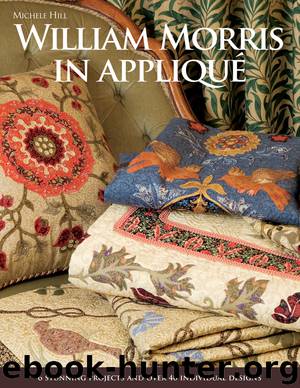William Morris in Applique by Michele Hill

Author:Michele Hill
Language: eng
Format: epub
Publisher: C&T Publishing
Sewing machine
For machine appliqué you will need a sewing machine with a neat close zigzag, a blanket stitch or other decorative appliqué stitch.
I prefer to use a machine blanket stitch because I find it easier to achieve a neat finish and the stitching is less dense than satin stitch and gives a delicate texture to this, sometimes intricate, appliqué. The less dense stitching also eliminates the need for stabilising the back of the work.
Tension
Adjusting the tension on the upper and lower threads allows you to create even stitches when stitching with different weights of thread such as embroidery rayon and quilting cotton. Always check your tensions whenever you change threads, as different weights need different adjustments. If the bobbin thread is showing on the top of your appliqué the tensions may need adjusting.
Bobbin tension. Check the tension by lifting out your bobbin shuttle. Hold the thread above the shuttle and gently tug it. If the thread shuttle falls away quickly it means the tension is too loose. To tighten, turn the screw very slightly to the right to tighten, ‘righty tighty’. If the shuttle doesn’t shift at all it is too tight so you need to turn the screw slightly to the left to loosen, ‘lefty loosey’.
Top tension. This can be adjusted following your machine manual instructions. If the bobbin tension is adjusted correctly and your bobbin thread is showing on the top then you need to turn your top tension down in numbers. So if 4 is normal you may have to turn tension down to 3 or even 2.
Stitch width and length
The width and length of stitches can be altered to suit your choice of zigzag or blanket stitches. I set my blanket stitch settings to 1.5 width and 1.5 length
Speed adjustment
Having a speed adjustment option on your machine is helpful especially if you are new to this technique. You will achieve a satisfying result particularly around curves if you go slowly, even one stitch at a time on sharper bends.
Feed dogs
When engaged, the feed dogs under the plate move the fabric under the presser foot allowing for smooth tension when stitching straight or smooth lines. For free motion quilting the feed dogs should be lowered to allow the fabric to be moved freely over the plate.
Presser feet
All purpose sewing foot. As the name suggests this foot is used for all general sewing, such as piecing and constructing the quilt.
Darning foot. This foot is used with the feed dogs lowered for free motion quilting.
Download
This site does not store any files on its server. We only index and link to content provided by other sites. Please contact the content providers to delete copyright contents if any and email us, we'll remove relevant links or contents immediately.
On Writing A Memoir of the Craft by Stephen King(4206)
The Doodle Revolution by Sunni Brown(4036)
A Simplified Life by Emily Ley(3565)
Mummy Knew by Lisa James(3164)
Marijuana Grower's Handbook by Ed Rosenthal(3114)
Paper Parties by Erin Hung(3037)
Better Homes and Gardens New Cookbook by Better Homes & Gardens(2950)
Figure Drawing for Artists by Steve Huston(2792)
Draw Your Day by Samantha Dion Baker(2703)
The Genius of Japanese Carpentry by Azby Brown(2602)
Japanese Design by Patricia J. Graham(2552)
Lions and Lace by Meagan Mckinney(2489)
Dangerous Girls by Haas Abigail(2463)
The Curated Closet by Anuschka Rees(2380)
Zero to Make by David Lang(2344)
How to Make Your Own Soap by Sally Hornsey(2334)
The Wardrobe Wakeup by Lois Joy Johnson(2230)
The Code Book by Simon Singh(2205)
The Checklist Manifesto by Atul Gawande(2199)
